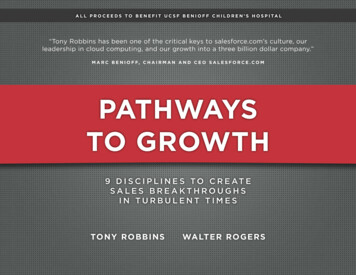
Transcription
11. PHOTOSYNTHETIC PATHWAYS - C3, C4 AND CAMDark reaction or Blackman’s reaction or Path of carbon in photosynthesisThis is the second step in the mechanism of photosynthesis. The chemical processesof photosynthesis occurring independent of light is called dark reaction. It takes place in thestroma of chloroplast. The dark reaction is purely enzymatic and it is slower than the lightreaction. The dark reactions occur also in the presence of light. In dark reaction, the sugarsare synthesized from CO2. The energy poor CO2 is fixed to energy rich carbohydrates usingthe energy rich compound, ATP and the assimilatory power, NADPH2 of light reaction. Theprocess is called carbon fixation or carbon assimilation. Since Blackman demonstrated theexistence of dark reaction, the reaction is also called as Blackman’s reaction. In dark reactiontwo types of cyclic reactions occur1. Calvin cycle or C3 cycle2. Hatch and Slack pathway or C4 cycleCalvin cycle or C3 cycleIt is a cyclic reaction occurring in the dark phase of photosynthesis. In this reaction,CO2 is converted into sugars and hence it is a process of carbon fixation. The Calvin cyclewas first observed by Melvin Calvin in chlorella, unicellular green algae. Calvin wasawarded Nobel Prize for this work in 1961. Since the first stable compound in Calvin cycle isa 3 carbon compound (3 phosphoglyceric acid), the cycle is also called as C3 cycle. Thereactions of Calvin’s cycle occur in three phases.1. Carboxylative phase2. Reductive phase3. Regenerative phase
1. Carboxylative phaseThree molecules of CO2 are accepted by 3 molecules of 5C compound viz., ribulosediphosphate to form three molecules of an unstable intermediate 6C compound. This reactionis catalyzed by the enzyme, carboxy dismutase3 CO2 3 RibulosediphosphateCarboxy dismutase 3 unstable intermediate 6carbon compoundThe three molecules of the unstable 6 carbon compound are converted by the addition of 3molecules of water into six molecules of 3 phosphoglyceric acid. This reaction is alsocatalyzed by the enzyme carboxy mutase.3 unstableintermediate 6 Ccompound 3 H2 OCarboxydismutase3 phosphoglyceric acid3 phosphoglyceric acid (PGA) is the first stable product of dark reaction of photosynthesisand since it is a 3 carbon compound, this cycle is known as C3 cycle.
2. Reductive phaseSix molecules of 3PGA are phosphorylated by 6 molecules of ATP (produced in thelight reaction) to yield 6 molecules of 1-3 diphospho glyceric acid and 6 molecules of ADP.This reaction is catalyzed by the enzyme, Kinase3 Phospho ATPglyceric acidKinase1,3 diphosphoglyceric acid ADPSix molecules of 1, 3 diphosphoglyceric acid are reduced with the use of 6 molecules ofNADPH2 (produced in light reaction) to form 6 molecules of 3 phospho glyceraldehyde. Thisreaction is catalysed by the enzyme, triose phosphate dehydrogenase.1,3 diphosphoglyceric acid NADPH2Triose phosphateDehydrogenase3 phosphoglyceraldehyde NADP H3PO43. Regenerative phaseIn the regenerative phase, the ribose diphosphate is regenerated. The regenerativephase is called as pentose phosphate pathway or hexose monophophate shunt. It involves thefollowing steps.1. Some of the molecules of 3 phospho glyceraldehyde into dihydroxy acetonephosphate. Both 3 phospho glyceraldehyde and dihydroxy acetone phosphate thenunite in the presence of the enzyme, aldolase to form fructose, 1-6 diphosphate.3 phosphoglyceraldehyde3 phosphoglyceraldehydeTriose phosphate isomeraseAldolaseDihydroxy acetone PO4(DHAP)Fructose 1,6 diphosphate DHAP2. Fructose 6 phosphate is converted into fructose 6 phosphate in the presence ofphosphorylaseFructose 1,6 diphosphatePhosphorylaseFructose 6 phosphate3. Some of the molecules of 3 phospho glyceraldehyde instead of forming hexose sugarsare diverted to regenerate ribulose 1-5 diphosphate3 phospho glyceraldehydeRibulose 1,5 diphosphate4. 3 phospho glyceraldehyde reacts with fructose 6 phosphate in the presence of enzymetransketolase to form erythrose 4 phosphate ( 4C sugar) and xylulose 5 phosphate(5Csugar)3 phosphoglyceraldehydeFructose 6 phosphateTransketolaseErythrose 4 phosphate Xylulose 5 phosphate
5. Erythrose 4 phosphate combines with dihydroxy acetone phosphate in the presence ofthe enzyme aldolase to form sedoheptulose 1,7 diphosphate(7C sugar)Erythrose 4 phosphate DHAPAldolaseSedoheptulose 1 ,7diphosphate6. Sedoheptulose 1, 7 diphosphate loses one phosphate group in the presence of theenzyme phosphatase to form sedoheptulose 7 phosphate.Sedoheptulose 1 ,7 ADPdiphosphatePhosphataseSedoheptulose 7phosphate ATP7. Sedoheptulose phosphate reacts with 3 phospho glyceraldehyde in the presence oftransketolase to form xylulose 5 phosphate and ribose 5 phosphate ( both % c sugars)Sedoheptulose7 phosphate 3 phosphoglyceraldehydeTransketolaseXylulose5 phosphateRibose 5 phosphate8. Ribose 5 phosphate is converted into ribulose 1, 5 diphosphate in the presence ofenzyme, phosphopentose kinase and ATP. Two molecules of xylulose phosphate arealso converted into one molecule of ribulose monophosphate. The ribulosemonophosphate is phosphorylated by ATP to form ribulose diphosphate and ADP,thus completing Calvin cycle.Ribose5 phosphate ATPPhophopentokinaseRibulose 1,5 ADPdiphosphate2 mols of Xylulose Phophopentokinase1 mol of Ribulose monoRibulose ATPPhophopentokinaseRibulose ADPphosphatephosphatemonodiphosphatephosphateIn the dark reaction, CO2 is fixed to carbohydrates and the CO2 acceptor ribulosediphosphate is regenerated. In Calvin cycle, 12 NADPH2 and 18 ATPs are required to fix 6CO2 molecules into one hexose sugar molecule (fructose 6 phosphate).6 CO2 12 NADPH2 18 ATPFructose 6 phosphate 12 NADP 18 ADP 17 Pi
Schematic diagram of light reaction and Calvin cycleC4 cycle or Hatch and Slack pathwayIt is the alternate pathway of C3 cycle to fix CO2. In this cycle, the first formed stablecompound is a 4 carbon compound viz., oxaloacetic acid. Hence it is called C4 cycle. Thepath way is also called as Hatch and Slack as they worked out the pathway in 1966 and it isalso called as C4 dicarboxylic acid pathway. This pathway is commonly seen in manygrasses, sugar cane, maize, sorghum and amaranthus.The C4 plants show a different type of leaf anatomy. The chloroplasts are dimorphicin nature. In the leaves of these plants, the vascular bundles are surrounded by bundle sheathof larger parenchymatous cells. These bundle sheath cells have chloroplasts. Thesechloroplasts of bundle sheath are larger, lack grana and contain starch grains. Thechloroplasts in mesophyll cells are smaller and always contain grana. This peculiar anatomyof leaves of C4 plants is called Kranz anatomy. The bundle sheath cells are bigger and looklike a ring or wreath. Kranz in German means wreath and hence it is called Kranz anatomy.The C4 cycle involves two carboxylation reactions, one taking place in chloroplasts ofmesophyll cells and another in chloroplasts of bundle sheath cells. There are four steps inHatch and Slack cycle:1. Carboxylation2. Breakdown
3. Splitting4. Phosphorylation1. CarboxylationIt takes place in the chloroplasts of mesophyll cells. Phosphoenolpyruvate, a 3 carboncompound picks up CO2 and changes into 4 carbon oxaloacetate in the presence of water.This reaction is catalysed by the enzyme, phosphoenol pyruvate carboxylase.PhosphoenolPyruvate (3C) CO2 H 2OPEP carboxylaseOxaloacetate (4C)H3PO42. BreakdownOxaloacetate breaks down readily into 4 carbon malate and aspartate in the presenceof the enzyme, transaminase and malate dehydrogenase.Oxaloacetate (4C)TransaminaseAspartate (4C) Malate (4C)Malate dehydrogenaseThesecompounds diffuse from the mesophyll cells into sheath cells.3. SplittingIn the sheath cells, malate and aspartate split enzymatically to yield free CO2 and 3carbon pyruvate. The CO2 is used in Calvin’s cycle in the sheath cell.MalateDecarboxylationCO2 PyruvateThe second Carboxylation occurs in the chloroplast of bundle sheath cells. The CO2 isaccepted by 5 carbon compound ribulose diphosphate in the presence of the enzyme, carboxydismutase and ultimately yields 3 phosphoglyceric acid. Some of the 3 phosphoglyceric acidis utilized in the formation of sugars and the rest regenerate ribulose diphosphate.4. PhosphorylationThe pyruvate molecule is transferred to chloroplasts of mesophyll cells where, it isphosphorylated to regenerate phosphoenol pyruvate in the presence of ATP. This reaction iscatalysed by pyruvate phosphokinase and the phophoenol pyruvate is regenerated.Pyruvate ATP PiPyruvatephosphokinasePhosphoenol pyruvateAMP PyrophosphateInHatch and Slack pathway, the C3 and C4 cycles of carboxylation are linked and this is due to theKranz anatomy of the leaves. The C4 plants are more efficient in photosynthesis than the C3plants. The enzyme, phosphoenol pyruvate carboxylase of the C4 cycle is found to have moreaffinity for CO2 than the ribulose diphosphate carboxylase of the C3 cycle in fixing themolecular CO2 in organic compound during Carboxylation.
Crassulacean Acid Metabolism (CAM) cycle or the dark fixation of CO2 in succulentsCAM is a cyclic reaction occurring in the dark phase of photosynthesis in the plantsof Crassulaceae. It is a CO2 fixation process wherein, the first product is malic acid. It is thethird alternate pathway of Calvin cycle, occurring in mesophyll cells. The plants exhibitingCAM cycle are called CAM plants. Most of the CAM plants are succulents e.g.,Bryophyllum, Kalanchoe, Crassula, Sedium, Kleinia etc. It is also seen in certain plants ofCactus e.g. Opuntia, Orchid and Pine apple families.CAM plants are usually succulents and they grow under extremely xeric conditions.In these plants, the leaves are succulent or fleshy. The mesophyll cells have larger number ofchloroplasts and the vascular bundles are not surrounded by well defined bundle sheath cells.In these plants, the stomata remain open during night and closed during day time. The CAMplants are adapted to photosynthesis and survival under adverse xeric conditions. CAMplants are not as efficient as C4 plants in photosynthesis. But they are better suited toconditions of extreme desiccation.CAM involves two steps:1. Acidification2. DeacidificationAcidification
In darkness, the stored carbohydrates are converted into phophoenol pyruvic acid bythe process of Glycolysis. The stomata in CAM plants are open in dark and they allow freediffusion of CO2 from the atmosphere into the leaf. Now, the phosphoenolpyruvic acidcarboxylated by the enzyme phosphoenol pyruvic acid carboxylase and is converted in tooxalaoacetic acid.Phosphoenol Pyruvate CO2 H 2OPEP carboxylaseOxaloacetic acid H3PO4The oxaloacetic acid is then reduced to malic acid in the presence of the enzymemalic dehydrogenase. The reaction requires NADPH2 produced in Glycolysis.Oxaloacetic acid NADPH2 Malic dehydrogenaseMalic acid NADP The malic acid produced in dark is stored in the vacuole. The malic acid increases the acidityof the tissues.DeacidificationDuring day time, when the stomata are closed, the malic acid is decarboxylated toproduce pyruvic acid and evolve carbon dioxide in the presence of the malic enzyme. Whenthe malic acid is removed, the acidity decreases the cells. This is called deacidification. Onemolecule of NADP is reduced in this reaction.Malic acid NADP Malic enzymePyruvic acid NADPH2 CO2The pyruvic acid may be oxidized to CO2 by the pathway of Kreb’s cycle or it may bereconverted to phosphoenol pyruvic acid and synthesize sugar by C3 cycle.The CO2released by deacidification of malic acid is accepted by ribulose diphosphate and is fixed tocarbohydrate by C3 cycle.CAM is a most significant pathway in succulent plants. The stomata are closed duringday time to avoid transpiration loss of water. As the stomata are closed, CO2 cannot enter intothe leaves from the atmosphere. However, they can carry out photosynthesis during the daytime with the help of CO2 released from organic acids. During night time, organic acids aresynthesized in plenty with the help of CO2 released in respiration and the CO2 entering from
the atmosphere through the open stomata. Thus, the CO2 in dark acts as survival value tothese plants.Comparison of the plants of C3 and C4 cycleC3 PlantC4 Plant1.Only C3 cycle is foundBoth C4 and C3 cycles are found.2.The efficiency of CO2 absorption at lowconcentration is far less and hence, theyare less efficient.The efficiency of CO2 absorption atlow concentration is quite high andhence, they are more efficient plants.3.The CO2 acceptor is Ribulose-1, 5diphosphate.The CO2 acceptor is phospho enolpyruvate.4.The first stable product is phosphoglyceric acid (PGA).Oxaloacetate (OAA) is the first stableproduct.5.Plants show one type of chloroplast(monomorphic type).Plants show dimorphic type ofchloroplast. The chloroplast ofparenchymatous bundle sheath isdifferent from that of mesophyll cells(dimorphic type). The chloroplasts inbundle sheath cell are centripetally
arranged and lack grana. Leaves showKranz type of anatomy.6.In each chloroplast, two pigmentsystems (Photosystem I and II) arepresent.In the chloroplasts of bundle sheathcells, the photosystem II is absent.Therefore, these are dependent onmesophyll chloroplasts for the supplyof NADPH H .7.The Calvin cycle enzymes are present inmesophyll chloroplast. Thus, the Calvincycle occurs.Calvin cycle enzymes are absent inmesophyll chloroplasts. The cycleoccurs only in the chloroplasts ofbundle sheath cells.8.The CO2 compensation point is 50-150ppm CO2.The CO2 compensation point is 0-10ppm CO2.9.Photorespiration is present and easilydetectable.Photorespiration is present only to aslight degree or absent.10. The CO2 concentration inside leafremains high (about 200 ppm).The CO2 concentration inside the leafremains low (about 100 ppm).11. The 13C/12C ratio in C-containingcompounds remains relatively low (both13CO2 and 12CO2 are present in air).The ratio is relatively high, i.e. C4plants are more enriched with 13C thanC3 plants.12. Net rate of photosynthesis in fullsunlight (10,000 – 12,000 ft. c.) is 15-25mg. of CO2 per dm2 of leaf area perhour.It is 40-80 mg. of CO2 per dm2 of leafarea per hour. That is, photosyntheticrate is quite high. The plants areefficient.13. The light saturation intensity reaches inthe range of 1000-4000 ft. c.It is difficult to reach saturation evenin full sunlight.14. Bundle sheath cells are unspecialized.The bundle sheath cells are highlydeveloped with unusual constructionof organelles.15. The optimum temperature for theprocess is 10-25 C.In these plants, it is 30-45 C andhence, they are warm climate plants.At this temperature, the rate ofphotosynthesis is double than that is inC3 plants.
16. 18 ATPs are required to synthesize oneglucose molecule.30 ATPs are required to synthesizeone glucose molecule.Factors affecting photosynthesisI. External factors1. LightIt is the most important factor of photosynthesis. Any kind of artificial light such aselectric light can induce photosynthesis. Out of the total solar energy, only 1-2 % is used forphotosynthesis and the rest is used for other metabolic activities. The effect of light onphotosynthesis can be studied under three categories.a. Light intensityWolkoff (1966) found that the arte of photosynthesis is directly proportional to lightintensity. But the extremely high light intensities do not favor for higher photosynthetic rates.The high light intensity which fails to accelerate photosynthesis is called light saturationintensity. Of the light falling on a leaf, about 80 per cent is absorbed, 10 per cent is reflectedand 10 % is transmitted. The rate of photosynthesis is greater in intense light than in diffusedlight. The plants are grouped into two types on the basis of light requirement.i. Heliophytes (Sun plants)ii. Sciophytes (Shade plants)At a specific light intensity, the amount of CO2 used in photosynthesis and theamount of CO2 released in respiration are volumetrically equal. This specific light intensity isknown as light compensation point.At very high light intensity, beyond a certain point, the photosynthetic cells exhibitphoto oxidation. This phenomenon is called solarisation and a result of this, inactivation ofchlorophyll molecules, bleaching of chlorophyll molecules and even inactivation of someenzymes take place resulting in the destruction of whole photosynthetic apparatus.Ingeneral, low light intensity favours stomatal closure and in turn reduced rate ofphotosynthesis.b. Light quality (wavelength)Photosynthesis occurs only in the visible part of the light spectrum i.e., between 400and 700 nm. The maximum rate of photosynthesis occurs at red light followed by blue light.
The green light has minimum effect and photosynthesis cannot take place either in theinfrared or in the ultraviolet light.c. Light durationIn general tropical plants get 10-12 hours of light per day and this longer period oflight favours photosynthesis.2. Carbon dioxideCO2 is one of the raw materials required for photosynthesis. If the CO2 concentrationis increased at optimum temperature and light intensity, the rate of photosynthesis increases.But, it is also reported that very high concentration of CO2 is toxic to plants inhibitingphotosynthesis.3. TemperatureThe rate of photosynthesis increases by increase in temperature up to 40 ºC and afterthis, there is reduction in photosynthesis. High temperature results in the denaturation ofenzymes and thus, the dark reaction is affected. The temperature requirement for optimumphotosynthesis varies with the plant species. For example, photosynthesis stops in manyplants at 0 ºC but in some conifers, it can occur even at -35 ºC. Similarly photosynthesisstops beyond 40-50 ºC in certain plants; but certain bacteria and blue green algae can performphotosynthesis even at 70 ºC.4. WaterWater has indirect effect on the rate of photosynthesis although it is one of the rawmaterials for the process. The amount of water utilized in photosynthesis is quite small andeven less than 1 per cent of the water absorbed by a plant. Water rarely acts as a limitingfactor for photosynthesis. During water scarcity, the cells become flaccid and the rate ofphotosynthesis might go down.5. OxygenOxygen is a byproduct of photosynthesis and an increase in the O2 concentration inmany plants results in a decrease in the rate of photosynthesis. The phenomenon of inhibitionof photosynthesis by o2 was first discovered by Warburg (1920) in green alga Chlorella andthis effect is known as Warburg’s effect. This is commonly observed in C3 plants.
In plants, there is a close relationship between Warburg’s effect and photorespiration.The substrate of photorespiration is glycolate and it is synthesized from some intermediatesof Calvin’s cycle. In plants that show Warburg’s effect, increased O2 concentration result indiversion of these intermediates of Calvin cycle into the synthesis of glycolate, therebyshowing higher rate of photorespiration and lower photosynthetic productivity.6. Mineral elementsThe elements like Mg. Fe, Cu, Cl, Mn, P etc are involved in the key reactions ofphotosynthesis and hence, the deficiency of any of these nutrients caused reduction inphotosynthesis.7. Chlorophyll contentIt is very much essential to tarp the light energy. In 1929, Emerson found directrelationship between the chlorophyll content and rate of photosynthesis. In general, thechlorophyll sufficient plants are green in colour showing efficient photosynthesis. Thechlorotic leaves due to irregular synthesis of chlorophyll or breakdown of chlorophyllpigment exhibit inefficient photosynthesis.8. LeafThe leaf characters such as leaf size, chlorophyll content, number of stomata. Leaforientation and leaf age are some of the factors that are responsible for photosynthesis. Themaximum photosynthetic activity is usually seen in the physiologically functional and fullsize leaves (usually third/fourth leaf from the tip of the shoot system).9. CarbohydratesIf the accumulated carbohydrates are not translocated, the photosynthetic rate isreduced and respiration is increased. Sugar is converted into starch and gets accumulated inthe chloroplasts. This reduces the effective surface in the chloroplast and the rate ofphotosynthesis is decreased.10. PhytohormonesTreharne (1970) reported first that photosynthesis may be regulated by plant hormonesystem. He found that gibberellic acid and cytokinin increase the carboxylating activity andphotosynthetic rates. Meidner (1967) also reported that kinetin @ 3µm causes 12 per centincrease in photosynthesis within one hour of the treatment.
PHOTORESPIRATIONThe excessive respiration that takes place in green cells in the presence of light iscalled as photorespiration. Decker (1955) discovered the process and it is also called as C2cycle as the 2 carbon compound glycolic acid acts as the substrate in photorespiration. Ingeneral, respiration takes place under both light and dark conditions. However in someplants, the respiration is more in light than in dark. It is 3-5 times higher than the rate ofrespiration in dark. Photorespiration is carried out only in the presence of light. But thenormal respiration is not light dependent and it is called dark respiration.In photorespiration, temperature and oxygen concentration play an important role.Photorespiration is very high when the temperature is between 25 and 30 ºC. The rate ofphotorespiration increases with the increase in the concentration of oxygen. Three cellorganelles namely chloroplast, peroxisome and mitochondria are involved in thephotorespiration. This kind of respiration is seen in plants like cotton, pulses, capsicum, peas,tomato, petunia soybean, wheat, oats, paddy, chlorella etc and it is absent in grasses.Mechanism1. In the presence of excess oxygen and low CO2 , ribulose 1,5 diphosphate produced in thechloroplast during photosynthesis is split into 2 phospho glycolic acid and 3 phosphoglyceric acid by the enzyme, ribulose 1,5 diphosphate oxygenase2. The 3 phospho glyceric acid enters the Calvin cycle.3. In the next step, phosphate group is removed from 2 phosphoglycolic acid to produceglycolic acid by the enzyme, phosphatase.4. Glycolic acid then it come out of chloroplast and enter the peroxisome. Here, it combineswith oxygen to form glyoxylic acid and hydrogen peroxide. This reaction is catalyzed by theenzyme, glycolic acid oxidase. Hydrogen peroxide is toxic and it is broken down into waterand oxygen by the enzyme, Catalase. Photorespiration is an oxidation process. In thisprocess, glycolic acid is converted into carbohydrate and CO2 is released as the by product.As glycolic acid is oxidized in photorespiration, it is also called as glycolate metabolism.5. The glyoxylic acid converted into glycine by the addition of one amino group with thehelp of the enzyme, amino transferase.
6. Now, the glycine is transported from the peroxisome into the mitochondria. In themitochondria, two molecules of glycine condense to form serine and liberate carbon dioxideand ammonia.7. Amino group is removed from serine to form hydroxyl pyruvic acid in the presence of theenzyme, transaminase.8. Hydroxy pyruvic acid undergoes reduction with the help of NADH to form glyceric acid inthe presence of enzyme alpha hydroxyl acid reductase.9. Finally, regeneration of 3 phosphoglyceric acid occurs by the phosphorylation of glycericacid with ATP. This reaction is catalyzed by the enzyme, Kinase.10. The 3 phosphoglyceric acid is an intermediate product of Calvin cycle. If it enters thechloroplast, it is converted into carbohydrate by photosynthesis and it is suppressednowadays with the increased CO2 content in the atmosphere.Significance of photorespiration1.Photorespiration helps in classifying the plantsGenerally, photorespiration is found in C3 plants and absent in C4 plants.2. Carbon dioxide is evolved during the process and it prevents the total depletion of CO2 inthe vicinity of chloroplasts.
2. The process causes oxidation of glycolic acid which arises as an unwanted byproduct ofphotosynthesis. The glycolic acid after oxidation is converted into carbohydrate but theremainder is converted into CO2.3. Photorespiration uses energy in the form of ATP and reduced nucleotides, but normalrespiration yields ATP and reduced nucleotides.4. It is believed that photorespiration was common in earlier days when CO2 content was toolow to allow higher rates.
The dark reaction is purely enzymatic and it is slower than the light reaction. The dark reactions occur also in the presence of light. In dark reaction, the sugars are synthesized from CO 2. The energy poor CO 2 is fixed to energy rich carbohydrates using the energy rich compound, ATP and the assimilato










